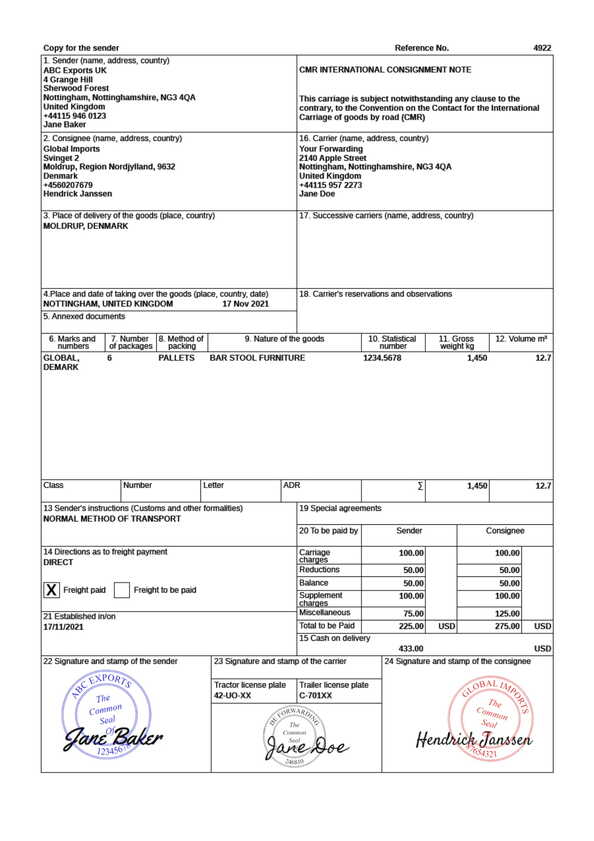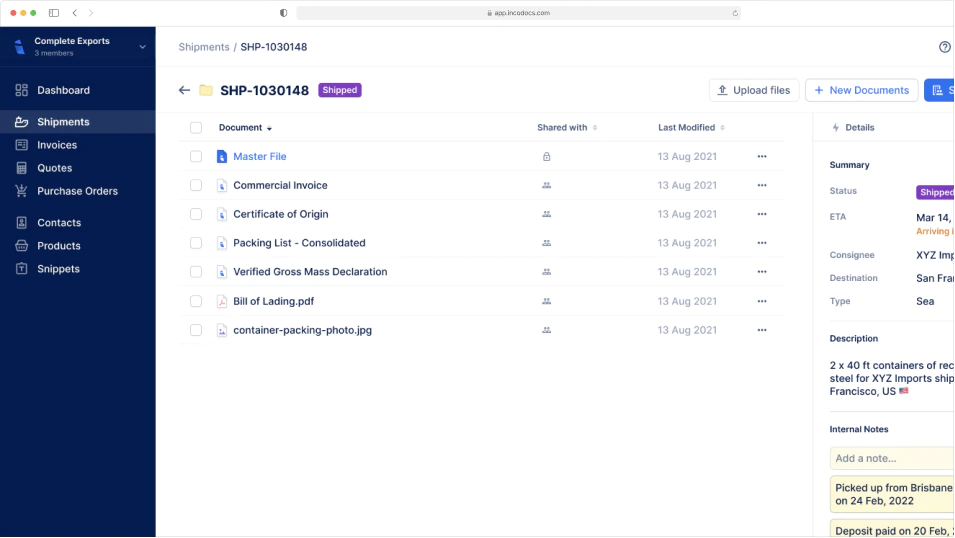IncoDocs raises $1.2M seed round led by Maersk GrowthRead the announcement

CMR Consignment Note Template
What is a CMR Consignment Note used for?
A CMR Consignment Note is used for international road freight. It acts as a contract between the sender and the road carrier. The document outlines transport conditions, liability terms, and the responsibilities of both parties. A CMR note is similar to a Bill of Lading, but it does not give its holder ownership of the goods. It simply confirms that the goods were received and details the terms agreed for delivery. The CMR helps protect both parties if the cargo is delayed, lost, or damaged during transit. Carriers may refuse to move goods without a complete CMR note, as it is required for cross-border road transport under the CMR Convention.
How to create a CMR Consignment Note
Open IncoDocs
Open IncoDocs in your browser and navigate to the “Export Docs” section.
Choose the CMR Consignment Note template
Click on 'New document set' and select the CMR Consignment Note template along with any other export documents you wish to create.
Fill out & customize your doc
Fill out the document, customize template fields to your needs and add your company letterhead. To save time and prevent re-entry errors, enter key shipment data into the Master File to have it sync across all other documents in your set automatically.
Sign & seal
Click on the signature box at the bottom of your document to create and place a digital signature then hit “Save & Quit”. On the document preview screen, click on the ‘More’ dropdown button and select “Add company seal” to place a digital stamp.
Download or share
Download or share documents from IncoDocs in 1-click. Documents can be downloaded as PDF or CSV which can be imported into other systems without manual re-entry.
Your questions, answered.
What is a CMR Consignment Note Document?
A CMR note is an International Consignment note that is the standard contract of carriage of goods document that is used for international road transport. The CMR note can also be known as a CMR Waybill or International Consignment Note (ICN).
The CMR Consignment note was defined under the 1956 United Nations Convention for the Contract of the International Carriage of Goods by Road, the CMR convention. CMR stands for ‘Convention relative au contrat de transport international de marchandises par route’, which can be translated to ‘Carriage of Merchandise by Road‘.
What is a CMR Consignment Note Document used for?
The CMR note contains a lot of important information that is agreed upon between the sender, the freight forwarder, and the carriage company or hauler.This document clearly states the responsibilities of both parties involved and forms a contract between the sender and the haulage company, and details the liability and transport conditions of carriage.
A CMR note is similar to a Bill of Lading, however the CMR note does not give it’s holder or carrier the rights of ownership of the goods. By documenting the responsibilities of both parties the CMR will help provide protection if the goods were to be damaged or lost whilst being transported.
The carriage company must have a CMR note to be able to commercially handle the transport of goods internationally via road. The carriage company has the right to refuse to transport the goods if a complete CMR note document is not provided.
What information is included on a CMR Consignment Note Document?
It’s important that shippers provide a completed CMR Consignment document to avoid having any issues or delays through the transport and delivery process. This document typically needs to contain the following:
Who is responsible for creating the CMR?
The sender or freight forwarder usually creates the CMR. It must be checked and signed by the carrier before the goods are collected. In some cases, the carrier fills in the form based on details provided by the sender. All parties should agree before transport begins.
Is a CMR required for all international road shipments?
Yes, a CMR note is required for most international road freight between countries that follow the CMR Convention. It acts as a legal contract between the sender and the carrier. Without it, the carrier may refuse to move the goods. Some non-convention countries may use different documents for cross-border road transport.
How long should CMR Consignment notes be kept?
CMR consignment notes should be stored for at least six years. This aligns with common rules for tax, freight, and customs documentation in international trade.
Keeping a clear record helps with audits, customs declarations, and claims for lost or damaged cargo. Digital storage is recommended for easy access, along with regular checks to meet compliance under the CMR Convention and local transport laws.
How many copies of the CMR Consignment Note are required?
Usually there are 4 copies of a CMR note:
Is this a free CMR template form?
Yes, the CMR template on IncoDocs is free to use. You can fill it out online, download it, or share it with others. To access the full form and save your progress, you’ll need a free IncoDocs account. It takes less than a minute to sign up and gives you access to more export documents.
Free to start,
Easy to use.
Setup in 5 mins.
